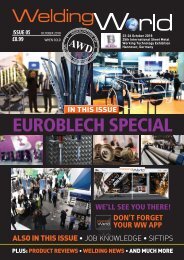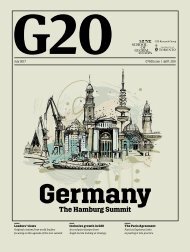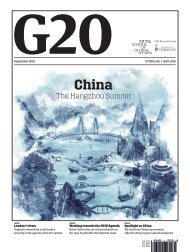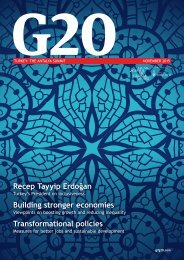SOURCE: Sustainable Development
SOURCE Sustainable Development magazine will be exploring the post 2015 international development landscape. It will engage the private sector to drive innovation and support the ever growing need to achieve the UN Sustainable Development goal’s
SOURCE Sustainable Development magazine
will be exploring the post 2015 international
development landscape.
It will engage the private sector to drive
innovation and support the ever growing
need to achieve the UN Sustainable
Development goal’s
You also want an ePaper? Increase the reach of your titles
YUMPU automatically turns print PDFs into web optimized ePapers that Google loves.
CITIES AND SUSTAINABLE INNOVATION<br />
City leaders are likely to play a<br />
prominent role in discussions<br />
drawing on lessons from initiatives<br />
that have developed city-based<br />
learning networks focused on<br />
developing low-carbon innovation.<br />
Innovation toward sustainability<br />
As part of the Big Data revolution, many<br />
companies are starting to explore the use of<br />
open innovation competitions to source ideas<br />
and funding from ‘the crowd’. A number<br />
of major companies have started to utilise<br />
crowd sourcing strategies related to the<br />
development of more sustainable solutions<br />
– they include big names like Unilever and<br />
GE.<br />
In parallel, a range of new initiatives are<br />
starting to emerge from city governments<br />
and civil society. These include ‘hackathons’<br />
and ‘jams’ focused on environmental or<br />
broader sustainability issues. Hackathons<br />
bring together computer software coders,<br />
programmers and other creatives in intensive<br />
sessions. They have been established by some<br />
cities to hack Big Data datasets to produce<br />
apps to improve, for example, recycling. At<br />
the leading-edge of this initiative are New<br />
York and Singapore, for example.<br />
Such sustainability-focused hackathons<br />
and jams – intensive ‘open’ innovation<br />
collaborative workshops – have also been<br />
organised by civil society groups from the<br />
‘bottom-up’. For example, last year the<br />
Sensors are monitoring air pollution levels in<br />
Barcelona - good news for the city’s cyclists<br />
38<br />
Futuristic metropolitan<br />
developments, such as<br />
Chengdu in China, set<br />
the benchmark for the<br />
smart cities concept<br />
Global Sustainability Jam documented<br />
around 80 simultaneous events worldwide in<br />
late November 2014.<br />
There are indications that traditional<br />
boundaries of innovation are starting<br />
to dissolve, with the potential means to<br />
innovate increasing from civil society<br />
and citizens. So are we moving into<br />
(or have already entered) a new age of<br />
industrialisation – ‘Industrialisation 4.0’ –<br />
that is based on information, collaboration,<br />
and decentralisation. The advent of this<br />
‘new Industrial Age’ appears to be driven by<br />
a new spirit of doing and making, increased<br />
access to information through Internet,<br />
increased sharing of ideas and information<br />
through social networking technologies,<br />
increased access to Open Source designs,<br />
availability of new ‘making’ tools such as<br />
additive manufacturing (or 3D printing), and<br />
new ‘places and spaces’ to enable individuals<br />
to ‘make, modify, and fix’.<br />
New places and spaces<br />
We may be starting to see the emergence of<br />
a new Industrial Renaissance. As indicated,<br />
these new ‘places and spaces’ are starting to<br />
emerge in many cities where individuals are<br />
coming together physically, face-to-face to<br />
discuss, collaborate, experiment, and share<br />
information and ideas to make, modify<br />
and/or repair products – products such as<br />
consumer goods. As indicated above, these<br />
new ‘places and places’ are part of a process<br />
of democratising innovation by providing<br />
access to the knowledge and equipment for<br />
prototype development and job production<br />
outside of corporate research and<br />
development laboratories and factories.<br />
Fab Labs<br />
Is this a threat or opportunity in relation<br />
to the established order? At present, this<br />
democratisation appears to be primarily<br />
in the spirit of experimentation but there<br />
some indications that some of these new<br />
‘places and spaces’ may start to incubate the<br />
development of new products and businesses.<br />
Perhaps the most well-known example of<br />
these new ‘places and spaces’ are the ‘Fab<br />
Labs’ that emerged from Massachusetts Institute<br />
of Technology in 2001, by providing<br />
organised facilities to enable individuals to<br />
fabricate products from digital images utilising<br />
a portfolio of manufacturing equipment<br />
including 3D printers and laser cutters.<br />
As of 2013, there were 125 Fab Labs in<br />
34 countries. Alongside Fab Labs, there has<br />
been the explosion of Makerspaces around<br />
the world, where organised facilities are<br />
being created or ‘opened up’ for individuals<br />
to network, design, and make products. For<br />
example, the RDM campus in Rotterdam in<br />
the Netherlands has established the RDM<br />
Makerspace where citizens can rent the<br />
use of equipment from the technical school<br />
SSD_<strong>Sustainable</strong> Cities.indd 38 04/03/2015 13:59
















